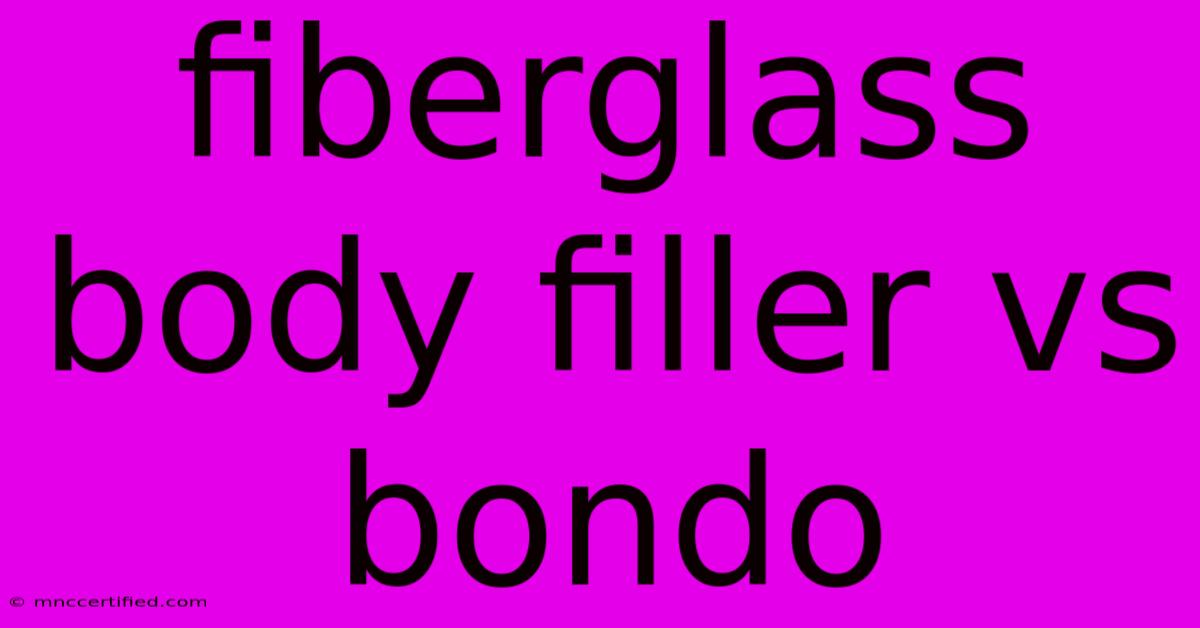Fiberglass Body Filler Vs Bondo

Table of Contents
Fiberglass Body Filler vs. Bondo: Which is Right for Your Project?
Choosing the right body filler can make or break your automotive repair or restoration project. Two popular choices often top the list: fiberglass body filler and Bondo (a brand name often used generically to refer to polyester-based body fillers). While both are used to fill imperfections in car bodies and other surfaces, they possess distinct characteristics that make them suitable for different applications. This comprehensive guide will delve into the key differences between fiberglass body filler and Bondo, helping you make an informed decision.
Understanding Fiberglass Body Filler
Fiberglass body filler, also known as fiberglass resin, is a composite material consisting of polyester resin reinforced with fiberglass strands. This combination results in a stronger, more flexible, and less prone to cracking filler compared to its polyester counterpart.
Advantages of Fiberglass Body Filler:
- Superior Strength and Flexibility: Its reinforced structure allows it to withstand significant stress and flex without cracking, making it ideal for larger repairs and areas subjected to vibration.
- Excellent Adhesion: Fiberglass body filler adheres well to various substrates, including metal, fiberglass, and wood.
- Durable Finish: When properly applied and sanded, it provides a smooth, durable surface for subsequent paint application.
- Resistant to Cracking: Its flexibility minimizes the risk of cracking, a common problem with polyester fillers on larger repairs.
Disadvantages of Fiberglass Body Filler:
- More Difficult to Apply: Requires more experience and skill due to its faster curing time and the need for proper mixing ratios.
- Shorter Pot Life: Once mixed, it has a limited working time before hardening.
- Can be More Expensive: Generally, more costly than standard polyester fillers.
- Requires Specific Hardener: Needs a suitable hardener designed specifically for fiberglass resin.
Understanding Bondo (Polyester Body Filler)
Bondo, often used as a generic term for polyester-based body fillers, is a less flexible, but easier-to-use alternative. It's a mixture of polyester resin and a catalyst that hardens upon mixing.
Advantages of Bondo:
- Ease of Application: Its longer working time allows for easier application, especially for beginners.
- Lower Cost: Typically less expensive than fiberglass body fillers.
- Widely Available: Readily available at most automotive supply stores.
- Easy Sanding: Sands relatively easily, even with hand tools.
Disadvantages of Bondo:
- Less Flexible and More Prone to Cracking: Its rigidity makes it susceptible to cracking, especially on larger repairs or areas prone to flexing.
- Lower Strength: Not as strong as fiberglass body filler, limiting its use in high-stress areas.
- Can Shrink: Some formulations can experience slight shrinkage during curing.
Fiberglass Body Filler vs. Bondo: A Head-to-Head Comparison
| Feature | Fiberglass Body Filler | Bondo (Polyester Body Filler) |
|---|---|---|
| Strength | High | Low |
| Flexibility | High | Low |
| Crack Resistance | Excellent | Poor |
| Ease of Use | More Difficult | Easier |
| Cost | More Expensive | Less Expensive |
| Working Time | Shorter | Longer |
| Application | Larger repairs, high-stress areas | Smaller repairs, less demanding areas |
Choosing the Right Filler for Your Project
The best choice depends heavily on your specific needs and the nature of the repair:
- Choose Fiberglass Body Filler for: Significant damage, repairs requiring high strength and flexibility, areas prone to vibration (like bumpers), and larger surface area repairs.
- Choose Bondo for: Small imperfections, minor dents, filling small holes, and repairs where flexibility isn't critical.
Important Note: Always follow the manufacturer's instructions carefully for both mixing ratios and application techniques. Proper preparation of the surface is crucial for achieving optimal adhesion and a durable finish with either product. Always use appropriate safety equipment, including gloves and a respirator, when working with body fillers.
By understanding the strengths and weaknesses of each product, you can select the most appropriate filler for your project, ensuring a successful and lasting repair. Remember that proper surface preparation and application techniques are key to achieving professional-looking results.

Thank you for visiting our website wich cover about Fiberglass Body Filler Vs Bondo. We hope the information provided has been useful to you. Feel free to contact us if you have any questions or need further assistance. See you next time and dont miss to bookmark.
Featured Posts
-
1st Test Highlights Australia Vs India
Nov 23, 2024
-
Mc Gregor Civil Case Assault Verdict
Nov 23, 2024
-
First Bond Movie Crossword Clue
Nov 23, 2024
-
Rooneys Absence From Coleens Show
Nov 23, 2024
-
Bondi Trumps Choice For Justice Department
Nov 23, 2024